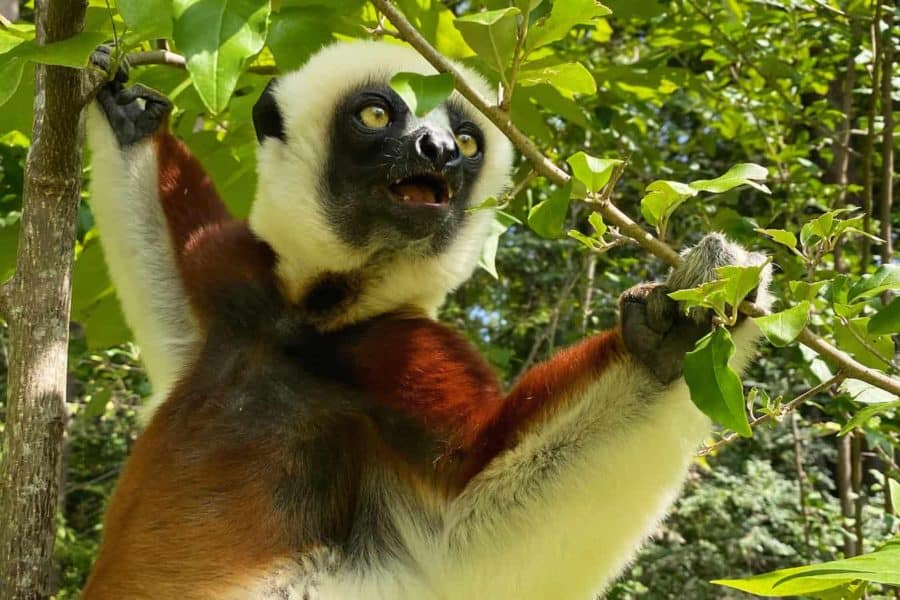A jungle. A rainforest. A wetland. A wilderness. Researchers have used various metaphors to describe the complex, interconnected community of microbes (most of them bacteria) living inside your body, and all over it too.
If you were to count up all the trillions of cells inside and out, we are more bacteria than human. Fortunately, perhaps, the microbes that make a cozy home inside your nose, or clinging to your teeth, aren’t the same ones that are living behind your ear or busily multiplying in your belly button.
The same is true for our distant primate cousins the lemurs, particularly in their guts, say researchers Lydia Greene and Erin McKenney in a new study.
Lemurs rely on gut microbes to digest their leafy diets, explains Greene, a research scientist at the Duke Lemur Center. Microbes in lemurs’ GI tracts help ferment plant fiber, detoxify plant chemical defenses, and synthesize vitamins and nutrients that lemurs can’t make for themselves. Our own gut bugs do many of the same things for us.
Greene and McKenney study how lemur gut bacteria are shaped by what lemurs eat, how they evolved and the complexity of the route microbes travel through the body. They hope to better understand how these microorganisms keep lemurs healthy, or — when they’re out of balance — make them sick.
Researchers who do this kind of work spend a lot of time collecting poop. For good reasons, says McKenney, an assistant professor at North Carolina State University. Scientists can learn about lemurs by what they leave behind, and poop can be collected repeatedly without harming the animals. But for this study the team tried something different, made possible by a one-of-a-kind biobank:
When an animal dies at the Duke Lemur Center, veterinary staff determine the cause of death, and blood and tissue samples that might be important for research or education are collected and preserved.
Today, the collection holds thousands of samples, collected over decades from more than two dozen species of rare and endangered primates, which the center stores in super cold freezers in their headquarters in North Carolina. It’s a frozen ark maintained at up to minus 80 degrees Celsius, with redundant backup power.
In the event that any one of these species goes extinct, and the last living parts of them are gone, future generations will still be able to study the genetic and other information they left behind.
Using this bank, the team sampled several sites in the bowels of 52 deceased lemurs, including dwarf lemurs, aye-ayes, ruffed lemurs, bamboo lemurs, brown lemurs, ring-tailed lemurs and sifakas.
A trip through a lemur’s GI tract is a journey through a varied landscape. The long, twisting route from the stomach through the small intestine to the colon serves numerous functions, filtering, digesting, absorbing, detoxifying, fermenting.
Not all lemur guts work the same: Fruit-eaters, like ruffed lemurs, generally have short, simple guts. If you stretched them out, they’d be five times their body length — not much shorter than ours, relative to body size. Leaf-eaters like sifakas have more complex GI tracts with relatively longer colons and a leaf-fermentation pouch called a cecum. Their guts are the lemur champions — up to 16 times body length.
Having whole lemurs to study instead of just poo enabled the researchers to sample different regions of the gut to figure out what kinds of microbes were present in each spot. They used genetic sequencing technology to identify microbes and compare their relative abundance in different sites.
Sampling along the digestive tract, they found that different spots along this long, twisting pathway have their own communities of bacteria doing different kinds of jobs. The complex ecosystem lurking in a lemur’s small intestine, for example, isn’t the same as the microbial menagerie setting up camp in their colon.
Levels of biodiversity varied too. The stomach supports less microbial life because fewer species can tolerate its acidic digestive juices. But if the upper regions of the gut are a garden, the lower regions are more like a tropical rainforest. About two dozen types of bacteria were more abundant in the cecum and colon than elsewhere. Lemurs with relatively longer lower guts host the richest microbiomes, to better ferment high-fiber foods.
“We probably couldn’t have detected these relationships without such an extensive comparative dataset,” McKenney said.
“This kind of lemur research can really only be done at the Duke Lemur Center,” Greene said.
This research was supported by the National Science Foundation (DBI PRFB 1906416) and by a Duke Lemur Center Director’s fund.
CITATION: “Gut Site and Gut Morphology Predict Microbiome Structure and Function in Ecologically Diverse Lemurs,” Lydia K. Greene, Erin A. McKenney, William Gasper, Claudia Wrampelmeier, Shivdeep Hayer, Erin E. Ehmke, & Jonathan B. Clayton. Microbial Ecology, May 14, 2022. DOI: 10.1007/s00248-022-02034-4


